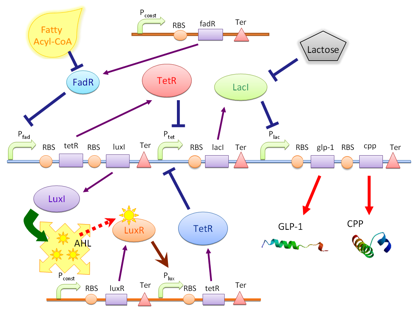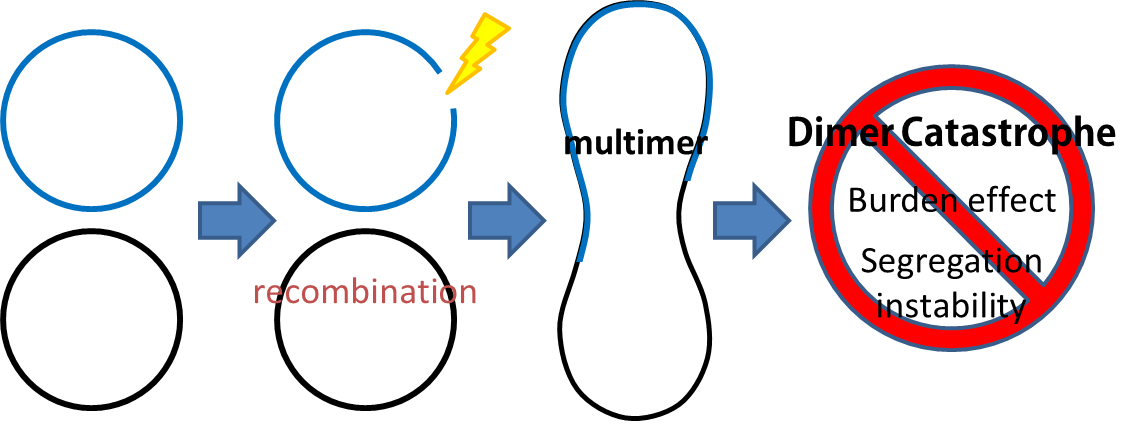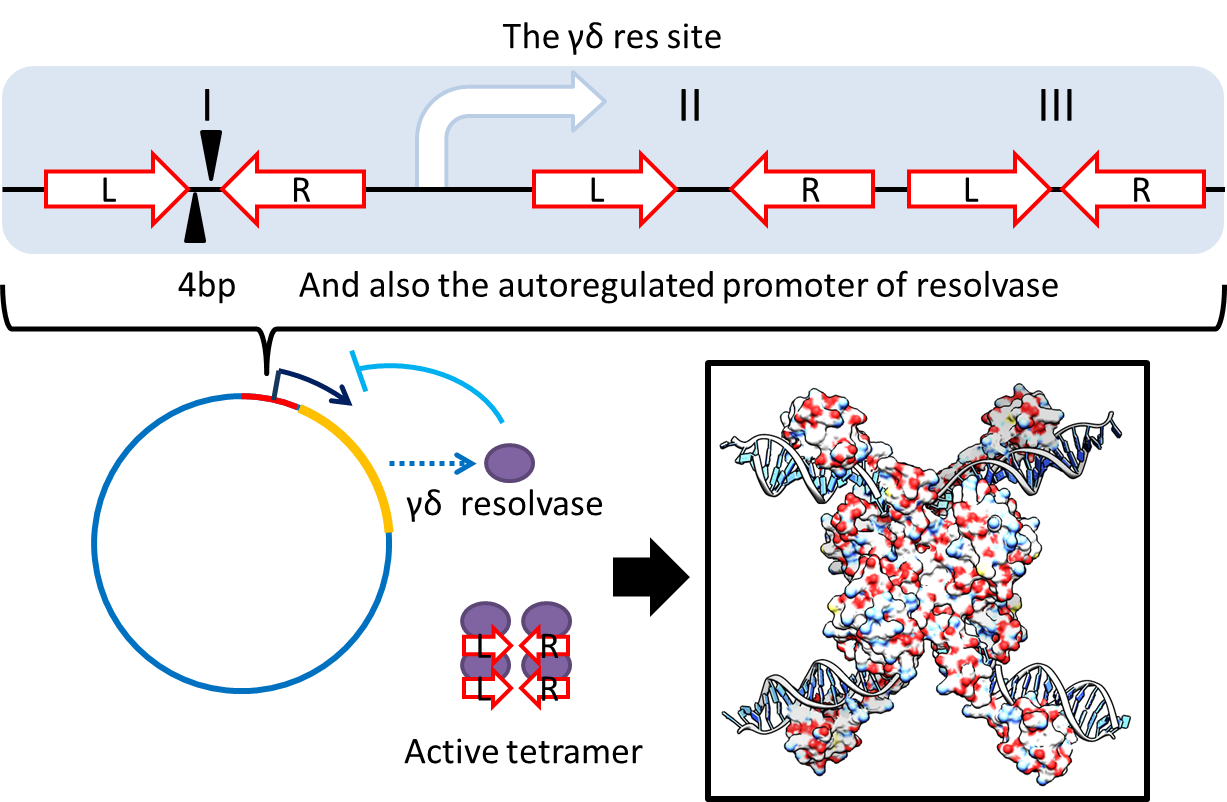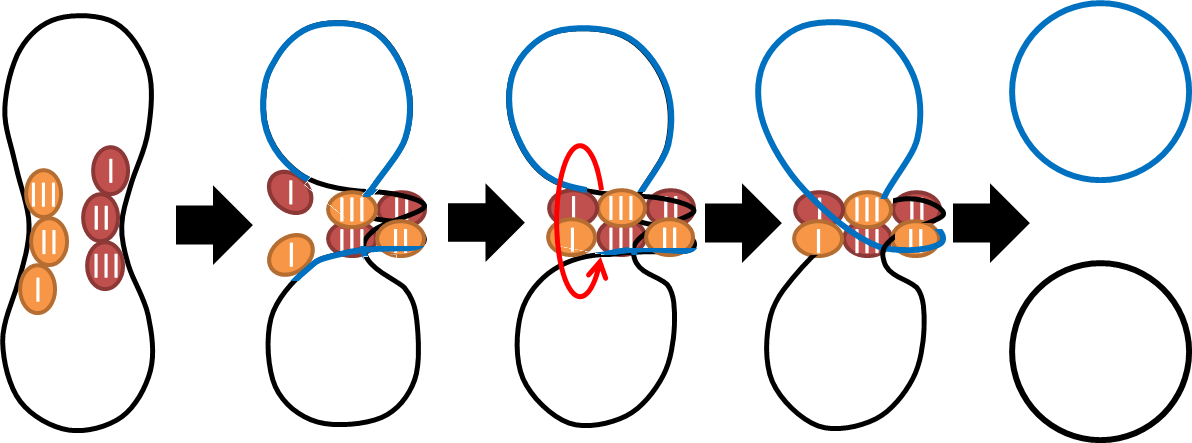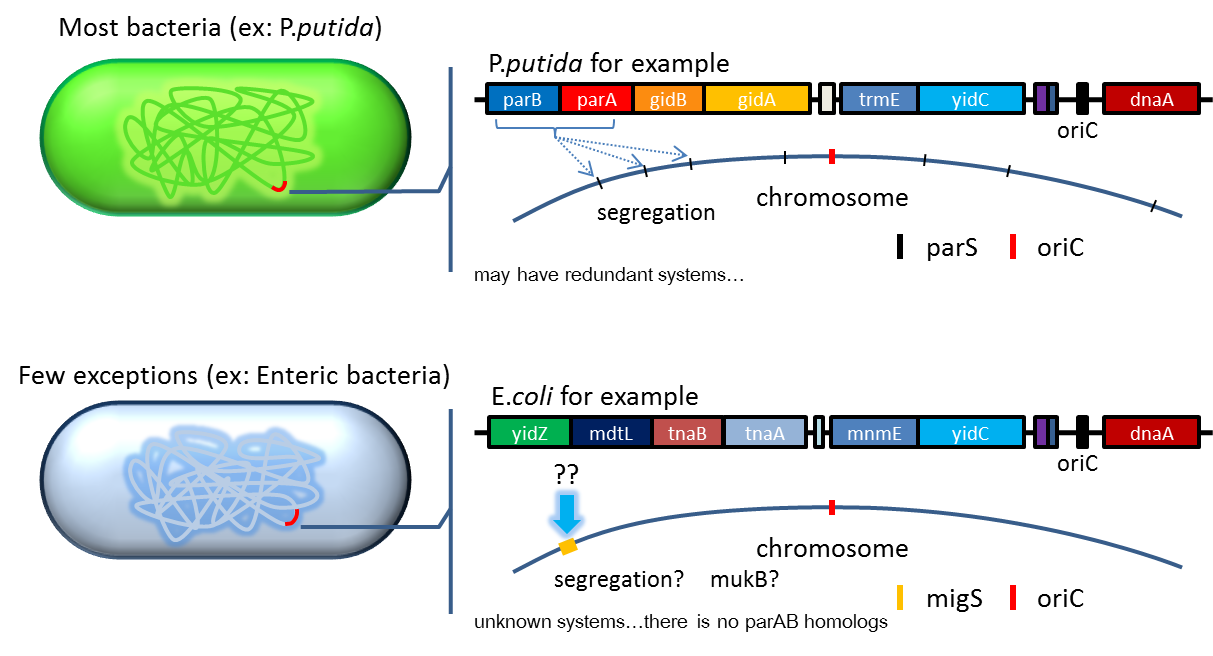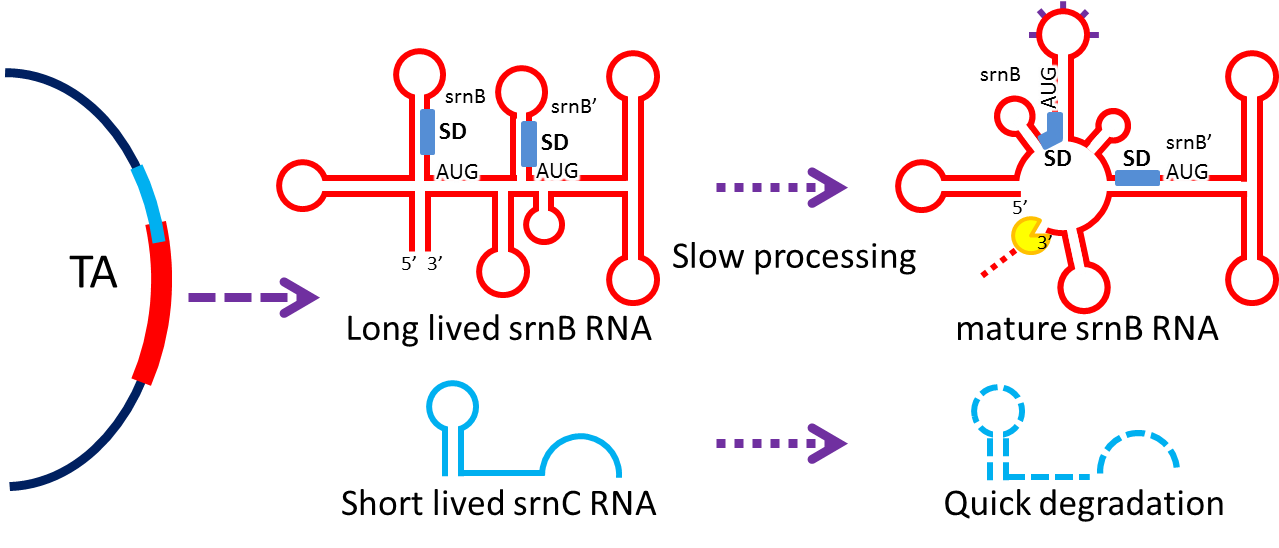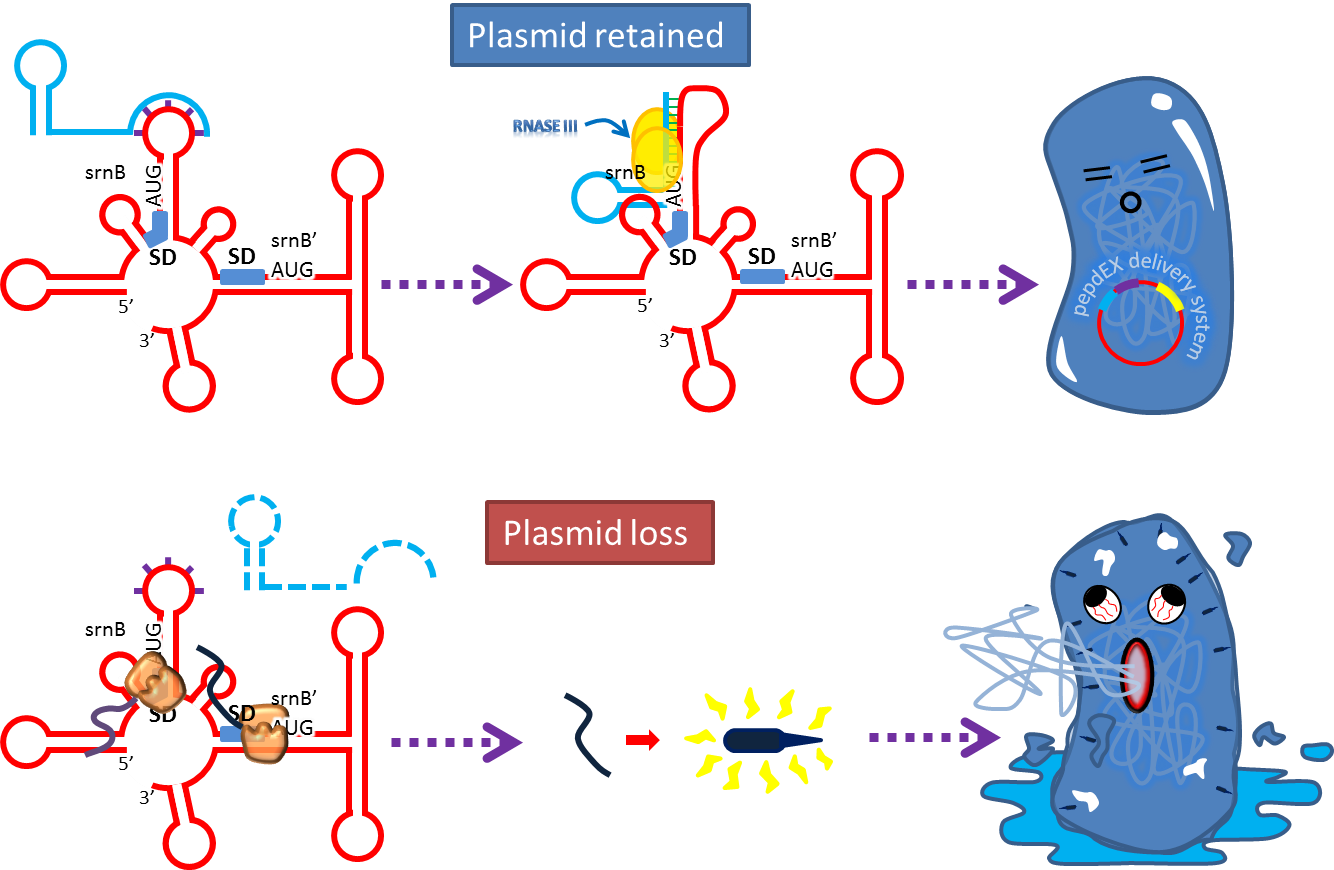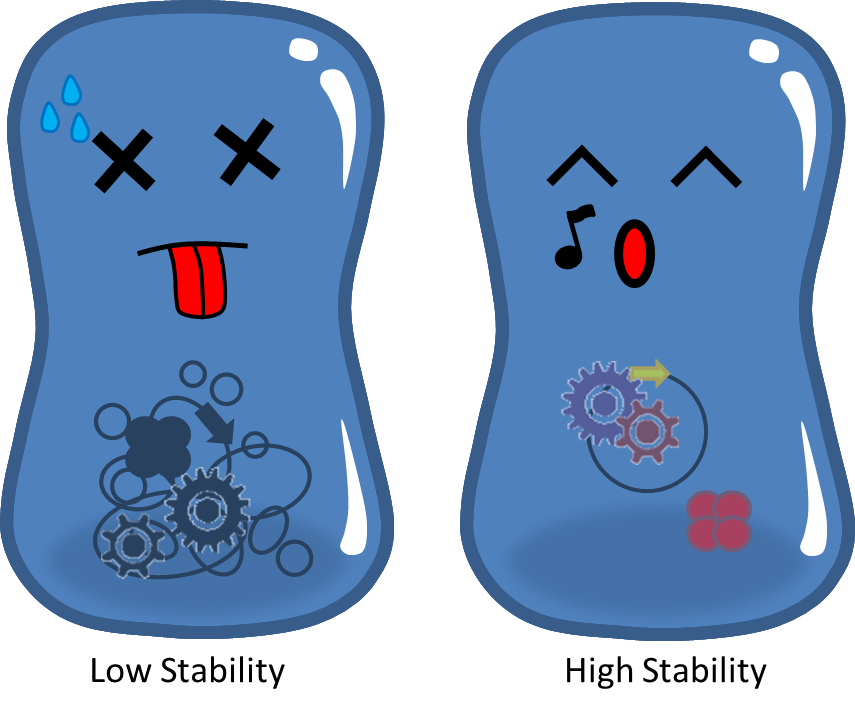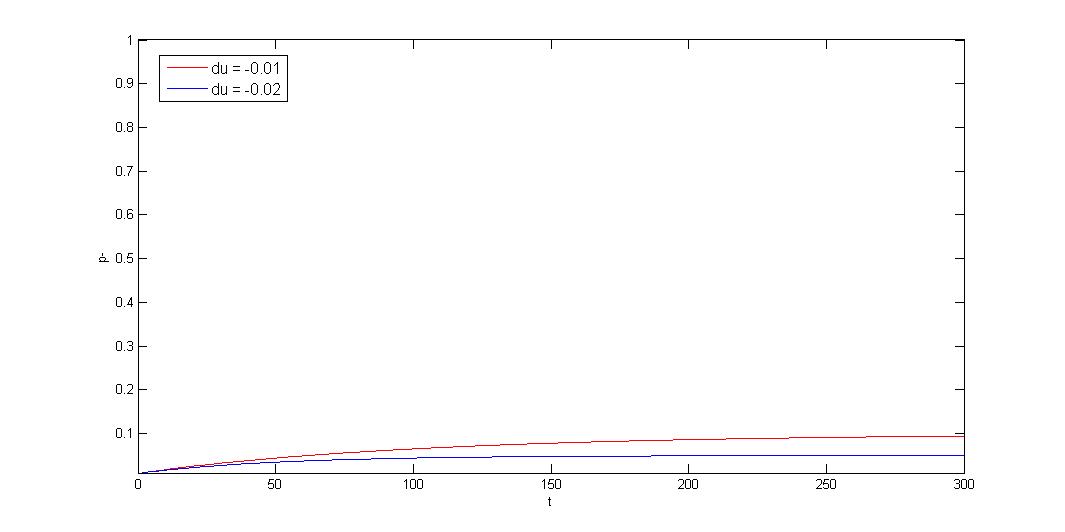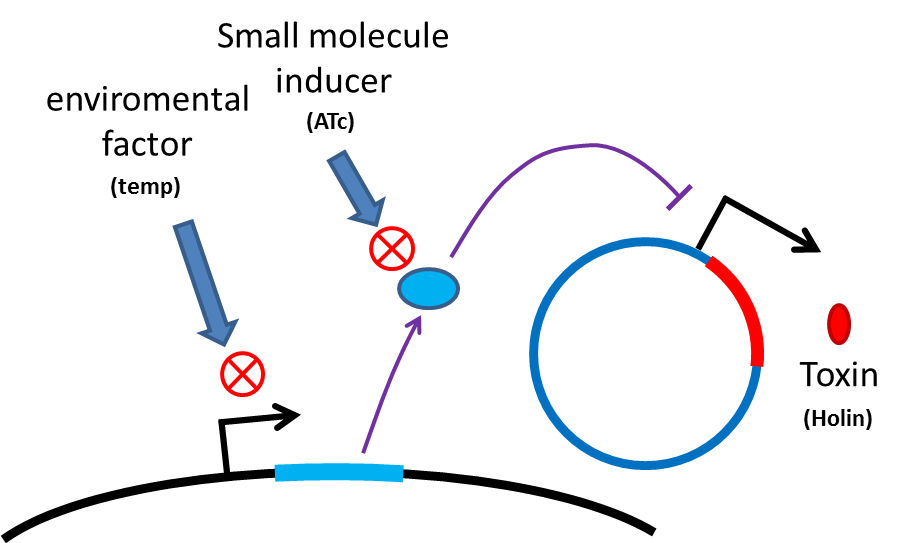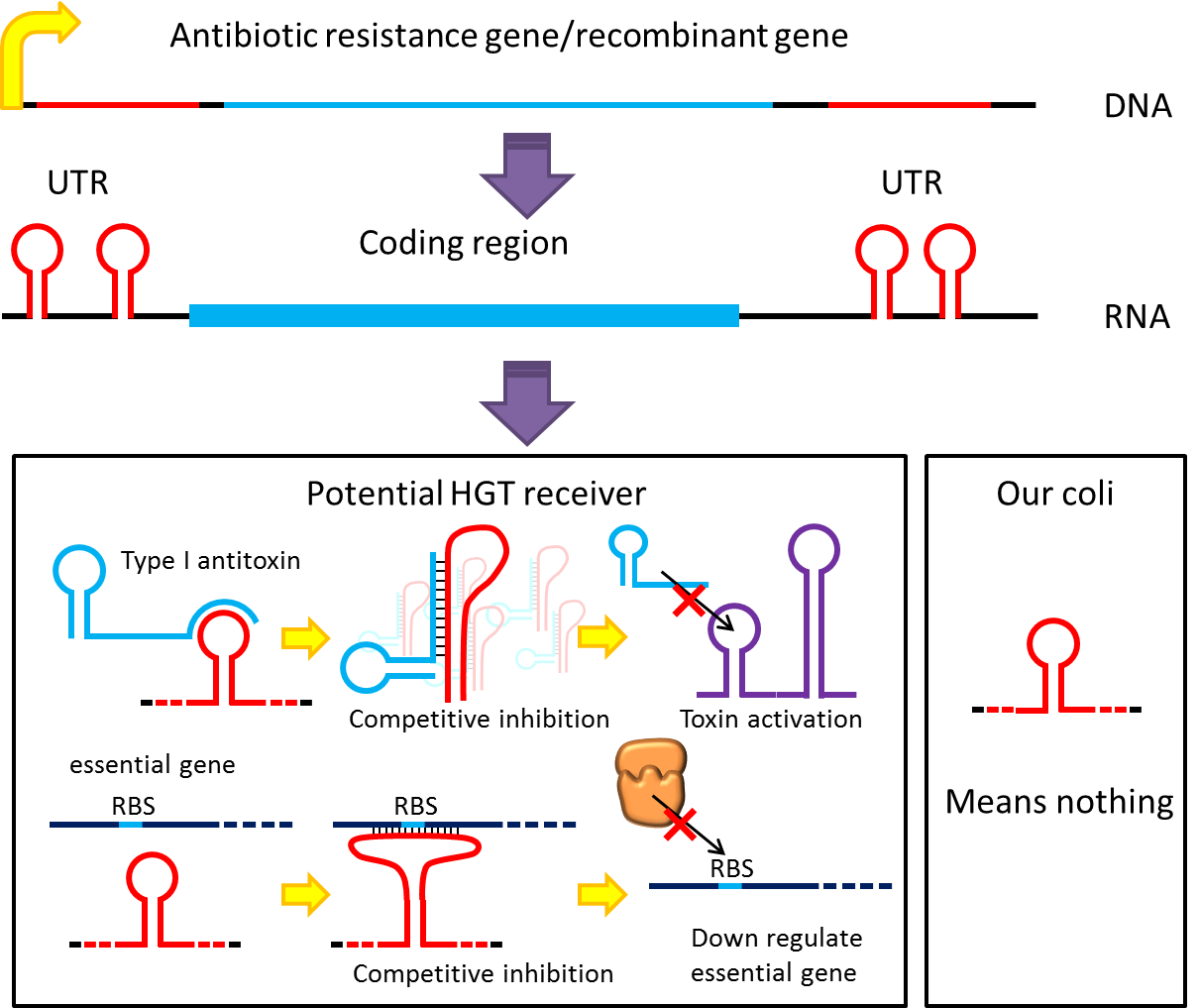Team:NTU-Taida/PEPDEX
From 2012.igem.org
Circuit
The main circuit is designed to detect the presence of fatty acid in the intestinal environment and produce the peptide drug (GLP-1 in this case) and cell penetrating peptide (CPP) as response. There are two core systems: double repressors and quorum sensing.
Contents |
Double Repressors
The double repressor system consists of the genes encoded Tet Repressor Protein (tetR) and lac reprresor (lacI). We put tetR downstream of fad promoter (Pfad) and lacI downstream of tet promoter (Ptet). The DNA sequence encoded GLP-1 and CPP are placed downstream of lac promoter (Plac).
In the absence of fatty acid, a constitutive expressed fatty acid metabolism regulator protein FadR binds to Pfad, which represses the transcription of tetR and makes Ptet free of TetR. Therefore LacI is expressed, binds to Plac and blocks the production of GLP-1 and CPP. After intake of a fat-rich meal, the fatty acid biosensor FadR is inhibited by the fatty acyl-CoA, which leads to the expression of TetR. The repression of the transcription of lacI by TetR frees the Plac from LacI and leads the final production of GLP-1 and CPP. When there is lactose in the intestinal environment (after drinking milk), the lactose can halt the repression of Plac directly by binding to LacI. GLP-1 and CPP can also be produced in this case.
Quorum Sensing
In order to amplify the response and to recruit other bacteria to work together when there are only a few of bacteria sense the fatty acid, a quorum sensing system is also included in our circuit. We place luxI downstream of Pfad and another tetR downstream of lux promoter (Plux). At the same time, the expression of LuxR is constantly driven by a constitutive promoter. When a single bacterium detects the fatty acid, LuxI is expressed and it catalyzes the synthesis of N-Acyl homoserine lactone (AHL). AHL activates the LuxR and binds to Plux, results in extra expression of TetR and amplifies the production of GLP-1 and CPP. AHL can be released into the environment and other bacteria that uptake the AHL can be recruited and start producing GLP-1 and CPP as well.
Appetite Regulating Hormone
Obesity has been regarded as chronic disease recent decades. It is reported that obese people are in a higher risk of type II diabetes, cardiovascular disease and hypertension. Nowadays, there are 1 billion people encountering over-weight problem, and 30 million people are diagnosed of obesity. Modern dietary pattern has been considered the major cause contributing to the phenomena.[12]
Incretins are a group of gastrointestinal hormones secreted by endocrine cells in small intestine that mainly work to increase insulin levels. Among all the incretins, glucagon-like peptide-1 (GLP-1) is one of the most widely used appetite inhibiting hormone for treating obese patients [1]. In normal physiological condition GLP-1 is secreted by intestinal L cells after a meal, promoting insulin release and inhibit energy intake [2]. The effect on feeding is signaling through G-protein coupled receptor in solitary tract and brainstem [3]. Beside appetite regulating effect, GLP-1 is also well known for its insulinotropic effect, which is useful for treating type II diabetes[14].
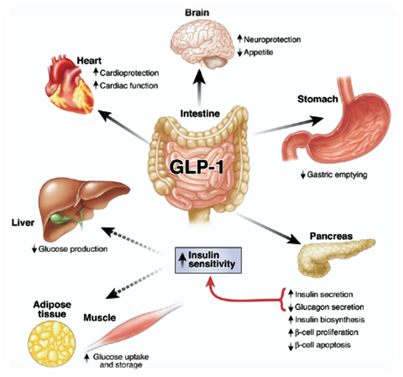
We want to generate a device which is not only helps people annoyed by obese problem, but also potentially effective for treating patients with type II diabetes. The half-life of GLP-1 in plasma is pretty short (5 minutes) because of the degradation by DPP-4 peptidase in serum[13], which is one of the reasons why we are thinking about using supplementary GLP-1 to treat obese patients. In addition, previous study has shown that patients with type II diabetes can be treated with delivery of GLP-1 plasmid construct into hepatic cells[4]. Therefore, by applying the similar philosophy to our bacterial device, we are looking forward to building a device that secret GLP-1 into intestinal lumen when the host is replete.
Fatty Acid Biosensor
in order to regulate the release of GLP-1, we decide to use a fatty acid biosensor which will switch on when the intestinal environment is filled with fatty nutrient. Our team chose fatty acid as a sensor of metabolic states for two main reasons. First, fatty acid is considered as the major cause to obesity because of their highly calorigenic effect. Second, GLP-1 level increases once the blood glucose concentration rises, but there is no significant GLP-1 secretion when the free fatty acid concentration increases in blood stream [15]. Therefore, we hope to compensate this weakness in the appetite regulating mechanisms. By designing the device that secrets GLP-1 on sensing fatty acid around, we aim to make a dietary bacteria.
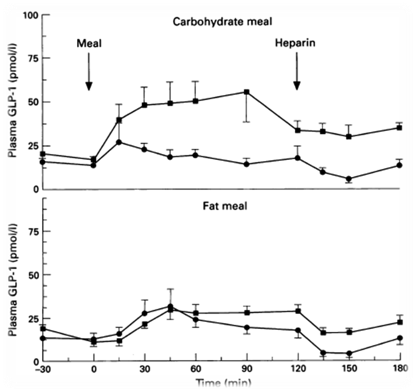
We use the natural fatty acyl-CoA biosensor, the fadBA promoter (PfadBA) from E. coli as the sensor in our design. [5] fadBA is one of the β-oxidation gene which E. coli turns on when the fatty acyl-CoA concentration in the surrounding rises. Therefore, we plan to clone the PfadBA as the promoter in our device, which enables the bacteria to detect fatty acid in the environment.
However, the baseline expression of the reportor gene (mRFP) downstream of PfadBA is so high that we cannot see significant signal rise after induction of fatty acid (oleic acid). Therefore, we decide to lower the baseline expression by overexpression of FadR, an endogenous repressor of PfadBA, whose repressive function is antagonized by fatty acyl-CoA. [6] By co-transforming constructs with PfadBA and FadR into the bacterial platform, it is made capable of changing gene expression in response to environmental fatty acid concentration and produce GLP-1 when the host is in taking a meal.
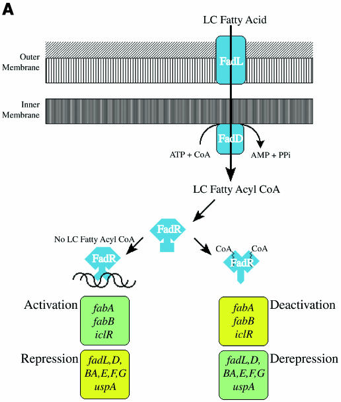
Cell Penetrating Peptide
One obstacle needs to be overcome is the poor penetrating ability of GLP-1 through the intestinal epithelia, since GLP-1 is neither small molecule nor hydrophobic. However, several studies have shown that some short peptides known as cell penetrating peptides (CPPs) can help to deliver biodrugs through intestinal mucosa and increase their bioavailability. [7] CPPs are usually arginine-rich, tend to interact with extracellular matrix and can enhance macropinocytosis of epithelial cells. [9] One recent study even demonstrated that co-administration of GLP-1 and Penetratin, one of the CPPs, greatly increased the intestinal absorption rate to 5%. [8] By applying cell penetrating peptide to our device, we aim to promote the delivery of GLP-1 from intestinal lumen to blood stream, therefore enhance their appetite-regulating effect.

Thermal Promoter
Phs thermal promoter (toxin, anti-toxin)
E. coli is pretty sensitive and responsive to temperature changes. We brought promoter Phs, located within dnaG, and transient induced to temperature upshift, to our circuit. As described by Wayne E. Talyor et al., Phs can forward upregulation of a series of proteins. The increase activity of Phs promoter is partially compatible with the increase synthesis of sigma factor. The quick respsonse of Phs is suitable since its the sigma factor synthesis peaks 10 minutes after the temperature upshift, and so does Phs RNA levels. The increase ratio before and after the temperature can be more than 20 folds. On particular note, Phs is lack of consensus region over -10 region, which explains its poor activity in 30 Celsuius degree. Thus, Phs is marked as a candidate in our circuit, which can only be functional after ingestion into human body.
We incorporate toxin and anti-toxin into our circuit, as a sensitive device to the environment. Holin, a membrane bound protein, can form complex with each other and trigger the disruption of the membrane. Anti-holin, which is bound to inner membrane, can bind and inactivate Holin. We put Holin under lac repressor control, and when temperature raises, the synthesis of Holin is repressed by LacI, and anti-Holin synthesis also add on to circumvent the lysis of the bacteria. However, when the temperature goes down, the synthesis Holin would not be suppressed, and thus poise for the cellular lysis. This design can make sure that our E. coli would not spread and grow outside of human body.
Modified promoter cI with CIts
This circuit involves a thermosensitive cI promoter under the expression of a strong promoter, J23119, and is followed by a CI promoter (PcI) region and reporter of desire. The whole composite circuit is designed by Harvard iGEM team, 2008. Under conditions demonstrated before, its increase of reporter expression after temperature upshift is minimal (1.8 fold). And thus, we design novel cI promoter region with alterer binding affinity to CIts repressor in search of better efficiency. The circuit aims to provide stable and sustainable GLP-1 synthesis inside human body, that is, the bacteria showed no ability to secret GLP-1 outside of human body under room temperature, under which the PcI is suppressed by CIts.
Stability and Safety
Every GM system that will function outside lab will face two major problems:system stability and safety! Without selective pressure ,we have to deal with plasmid instability ; to make our coli colonized bowel we have to use recA+ strains which may cause plasmid multimer. Our GM coli will also contact with many kinds of bacteria at the risk of horizontal gene transfer.
The following segment is our struggle against these obstacles.
Stability of Delivery System
Briefing
As our system will function outside the labrotory and human gut lack for antibiotic selection pressure, the vector stability is the critical point that determine whether our system is applicable or not. Inspired by natural plasmid & mobile gene element, we cope up with vector instability by incorporating partition system, Multimer resolution system and toxin antitoxin system these modules into our design.
Obstacles
Sources of plasmid instability:
- Segregational instability
Plasmids are unevenly distributed inside bacterium, after cell division, some progeny might loss plasmid.
- Burden Effect
The plasmid free cells sure will grow better than those bearing plasmids because they don't have to spend energy/resources on our pepdEX system, so this growth rate difference will finally eliminate plasmid-bearing bacteria in population
- Dimer Catastrophe
Homologues recombination may cause plasmid multimers which will increases segregational instability and burden, this is the reason why most lab coli are recA1 mutants. But so that our coli must able to colonize gut, it should be recA+ wild type strain. That's the problem!
Stabilization Modules
1. Multimer Resolution System:Tn1000(gamma delta) resolution system
- To deal with multimerization, we clone an cassette which encodes an autoregulated resolvase(serine type recombinase)from E.coli F plasmid transposon tn1000(tn3 family). Its promoter region consists of 3 sub-sites(res site) and can process recombination. This cassette can resolve multimer that formed during replicative transposition, so it can also resolve plasmid multimer providing plasmid stability by avoiding dimer catastrophe. For this reason, it is multimer resolution system(MRS) that provide analogous function as E.coli chromosome XerCD/dif but acts independent of cell cycle, DNA localization and may have higher efficiency on plasmids compared with slow XerCD system.
2. Partition System:from Pseudomonas putidaKT2440
- Just like many low copy plasmid, bacterial chromosome distribute chromosome evenly to their progeny by certain dynamic system. These systems include SMC like proteins, type Ia partition system and so on. Type Ia partition system segregate chromosome/plasmid in a process akin to Eukaryotic mitosis,it can be found on most eubacteria but E.coli is not the case.
- Previous study have shown that when provide parAB of P.putida in trans, the low copy plasmid(mini F)carrying conserved parS site can be stabilized in E.coli.(Anne-Marie etl. 2002)pSB2K3 is mini F plasmid thus can be stabilized by this way too, we make a new version of pSB2K3 with parS site. This plasmid that have lower gene dosage(copy number)and can be partitioned is an ideal vector to harbor our pepdEX system.
3. Post-Segregation Killing:srnBC toxin-antitoxin system
- No matter how well partition system and multimer resolution system work, inevitably there still will have some bacteria losing plasmid. We sentence them to death to solve the problem.
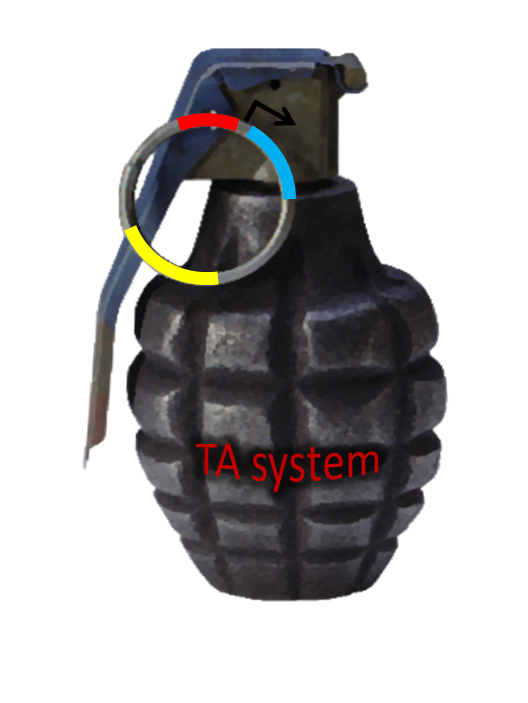
| 
|
- Type I toxin-antitoxin srnBC is an ideal executor which belongs to hok/sok homologues, it expresses stable toxin encoded RNA and short lived antitoxin RNA that can neutralize toxin RNA by RNA interaction and RNase III cleavage. It acts as post segregation killing system, which kills bacteria when it loss the DNA(genomic islands, plasmids, mobile gene elements) that contains it. Therefore we use it to reduce plasmid loss rate and make applications without antibiotic selection more feasible.
4. Reduce Burden Effect
- Besides these modules, reducing the burden effect is also important to the system stability. Well designed system and lower gene dosage may help.
- High level gene expression and gene dosage cause burden effect. If having the same outcome, low copy plasmid is preferred to high copy ones. If having the same outcome and not for regulatory purpose, stabilizing mRNA is preferred to overexpression it. Place yourselves in E.coli's position, reduce its metabolic burden as much as possible then it can work for you.
Modeling and Application
How to model plasmid instability:
We use Cooper's model (Cooper, N.S., M.E. Brown, and C.A. Caulcott, A ) to model plasmid instability, and set a protocol to suggest users which modules can be used to prove their system stability. Click upper button "modeling" for detail or press following link.
Safety of Delivery System
Many turn off strategies have been developed, most of these are the inducible suicide system that can be activated at certain condition. For instance, in our project, we plan to use temperature and small molecule as activating signals( following picture). When the course of treatment ends, administration of small amount of tetracycline agonist will induce bacterial to commit suicide, leaving human body also cause suicide gene activation thereby avoid recombinant strain/gene polluting. And splitting suicide system to provide repression in trans can prevent plasmid transfering to wild type strains. There have been many off-the-rack parts can be used.
However, these design cannot totally eliminate the risk of horizontal gene transfer(HGT), which recombinant genes can move to other organisms independent of suicide system. So besides suicide system, we have a new idea to deal with these kinds of HGT risks by RNA interaction.
Although bacteria lack for RNAi pathway, expressing well designed antisense RNAs have been shown to have inhibitory effect on target RNAs through competitive inhibition, and recent study showed that peptide nucleic acid (PNA) that antisense to antitoxin RNA 5' sequence can cause bacteria death. Putting appropriate antisense RNAs on untranslated region of transcripts may interfere target RNA function or translation. This property might be used to prevent HGT. For instance, HGT is more likely to occur between related species like lab E.coli & O157, laboratory E.coli have inactivated all its hok/sok toxin-antitoxin system by mutation, but wild bacteria especially pathogenic bacteria usually have more active TA locus on its chromosome like E.coli O157. we plan to put a stem loop from hok mRNA which can pair with sok RNA 5’sequence on UTR of antibiotic resistance genes we used in pepdEX system. IF wild bacteria steal our antibiotic resistance genes and express it, its antitoxin will be competitive inhibited and its toxin will express and kill the thief thus preventing HGT between lab & wild coli. This idea can have wide extension. Besides targeting antitoxin (functional RNA) of type I TA, designing antisense sequences that target RBS to down regulate targeted protein is also possible. Targeting antitoxin of type II TA, essential genes for metabolism, housekeeping genes and any sequences exist in potential HGT receivers but not our coli can be used. Even if the design cannot kill thieves, it can weaken receivers and reduce advantages antibiotic genes bring about thus reduce possibility and danger of HGT.
In the past the repression efficiencies of antisense RNA in bacteria are low, but after invention of the paired termini antisense RNA(PTasRNA) method and incorporate U turn/YUNR motif etc., this idea will become more and more feasible.
Reference
- The Gut Hormones PYY3-36 and GLP-17-36 amide Reduce Food Intake and Modulate Brain Activity in Appetite Centers in Humans.
- The gastrointestinal tract and the regulation of appetite.
- The Multiple Actions of GLP-1 on the Process of Glucose-Stimulated Insulin Secretion
- Glucagon-like Peptide-1 Plasmid Construction and Delivery for the Treatment of Type 2 Diabetes.
- Design of a dynamic sensor-regulator system for production of chemicals and fuels derived from fatty acids.
- Unexpected Functional Diversity among FadR Fatty Acid Transcriptional Regulatory Proteins.
- Oral biodrug delivery using cell-penetrating peptide
- Efficiency of cell-penetrating peptides on the nasal and intestinal absorption of therapeutic peptides and proteins.
- Cellular Uptake of Arginine-Rich Peptides: Roles for Macropinocytosis and Actin Rearrangement
- Biology of Incretins: GLP-1 and GIP
- Crystal structure of FadR, a fatty acid-responsive transcription factor with a novel acyl coenzyme A-binding fold.
- Obesity and Overweight
- Active glucagon-like peptide-1 (GLP-1): Storage of human plasma and stability over time.
- One week's treatment with the long-acting glucagon-like peptide 1 derivative liraglutide (NN2211) markedly improves 24-h glycemia and alpha- and beta-cell function and reduces endogenous glucose release in patients with type 2 diabetes
- Attenuated GLP-1 secretion in obesity: cause or consequence?
 "
"


